Great stellated dodecahedron
| Great stellated dodecahedron | |
|---|---|
 | |
| Type | Kepler–Poinsot polyhedron |
| Stellation core | regular dodecahedron |
| Elements | F = 12, E = 30 V = 20 (χ = 2) |
| Faces by sides | 125 |
| Schläfli symbol | {5/2,3} |
| Wythoff symbol | 3 | 25/2 |
| Coxeter diagram | |
| Symmetry group | Ih, H3, [5,3], (*532) |
| References | U52, C68, W22 |
| Properties | Regular nonconvex |
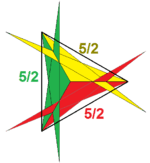 (5/2)3 (Vertex figure) |
 Great icosahedron (dual polyhedron) |
In geometry, the great stellated dodecahedron is a Kepler-Poinsot polyhedron, with Schläfli symbol {5/2,3}. It is one of four nonconvex regular polyhedra.
It is composed of 12 intersecting pentagrammic faces, with three pentagrams meeting at each vertex.
It shares its vertex arrangement with the regular dodecahedron, as well as being a stellation of a (smaller) dodecahedron. It is the only dodecahedral stellation with this property, apart from the dodecahedron itself. Its dual, the great icosahedron, is related in a similar fashion to the icosahedron.
Shaving the triangular pyramids off results in an icosahedron.
If the pentagrammic faces are broken into triangles, it is topologically related to the triakis icosahedron, with the same face connectivity, but much taller isosceles triangle faces.
Images
| Transparent model | Tiling |
|---|---|
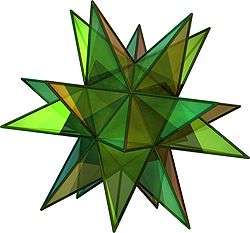 Transparent great stellated dodecahedron (Animation) |
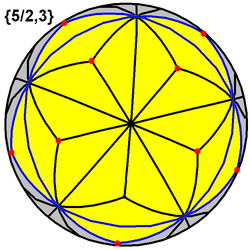 This polyhedron can be made as spherical tiling with a density of 7. (One spherical pentagram face is shown above, outlined in blue, filled in yellow) |
| Net | Stellation facets |
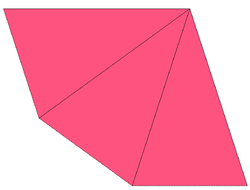 × 20 × 20A net of a great stellated dodecahedron (surface geometry); twenty isosceles triangular pyramids, arranged like the faces of an icosahedron |
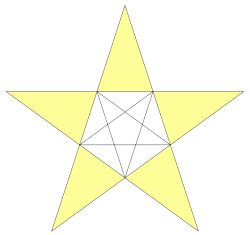 It can be constructed as the third of three stellations of the dodecahedron, and referenced as Wenninger model [W22]. |
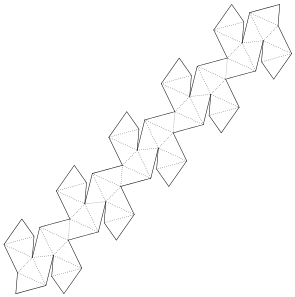 Complete net of a great stellated dodecahedron. |
Related polyhedra
A truncation process applied to the great stellated dodecahedron produces a series of uniform polyhedra. Truncating edges down to points produces the great icosidodecahedron as a rectified great stellated dodecahedron. The process completes as a birectification, reducing the original faces down to points, and producing the great icosahedron.
The truncated great stellated dodecahedron is a degenerate polyhedron, with 20 triangular faces from the truncated vertices, and 12 (hidden) pentagonal faces as truncations of the original pentagram faces, the latter forming a great dodecahedron inscribed within and sharing the edges of the icosahedron.
| Name | Great stellated dodecahedron |
Truncated great stellated dodecahedron | Great icosidodecahedron |
Truncated great icosahedron |
Great icosahedron |
|---|---|---|---|---|---|
| Coxeter-Dynkin diagram |
|||||
| Picture |  |
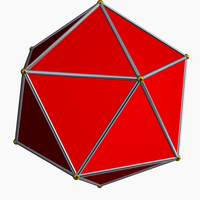 |
 |
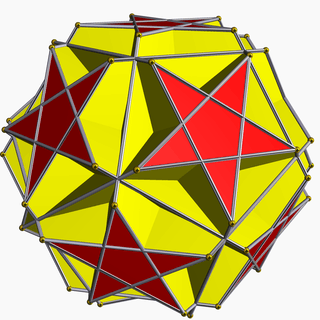 |
 |
References
- Wenninger, Magnus (1974). Polyhedron Models. Cambridge University Press. ISBN 0-521-09859-9.
External links
| Stellations of the dodecahedron | ||||||
| Platonic solid | Kepler–Poinsot solids | |||||
| Dodecahedron | Small stellated dodecahedron | Great dodecahedron | Great stellated dodecahedron | |||
|---|---|---|---|---|---|---|
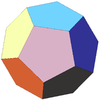 |
 |
 |
 | |||
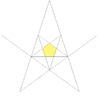 |
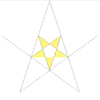 |
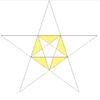 |
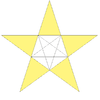 | |||